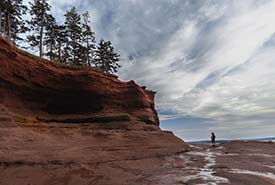Going batty in BC

Early morning scene of a small town in Transylvania, Romania, while volunteering with Operation Wallacea, Romania chapter. (Photo by Katie Bell)
The moon is full and bright, with fog settled in the valley, making for an eerie view. It is early morning, just before sunrise. I am with a group of volunteers and one biologist. We are on our way back to camp after a two-hour walk around a small...
Coasting along Canada’s habitats

Musquash Estuary, NB (Photo by NCC)
Canada is a nation bordered by three oceans: Pacific, Arctic and Atlantic. In many ways, the habitats, local culture and economies are shaped by them. Often when those of us who don’t live near the shoreline think of oceans, we picture a...
Invasive, shrimp-sucking parasite continues northward Pacific expansion

The cough drop-sized parasite Griffen's isopod, native to Asia and Russia, has decimated mud shrimp populations along the West Coast. The parasite on the right is a female with the much smaller male attached. (Florida Museum photo by Amanda Bemis and Gustav Paulay)
By Josh Silberg and Natalie van Hoose Researchers have identified an invasive, blood-sucking parasite on mud shrimp in the waters of British Columbia’s Calvert Island. The discovery represents the northernmost record of the parasite on the...
Seeing Canada through the trees: How Canadians can lead the world in forest conservation

Whitemouth River Watershed Natural Area, MB (Photo by Mike Dembeck)
Forests define our Canadian geography and identity. One-third of our country is covered with trees, and forests occur in every province and territory. Jobs in forestry employ more than 200,000 Canadians and support many Indigenous and northern...
A throwback to working in Backus Woods

Forest canopy in Backus Woods, ON (Photo by Neil Ever Osborne)
I had the pleasure of working for the Nature Conservancy of Canada (NCC) for the summer of 2019 as a conservation technician out of the Norfolk County, Ontario, office. When I first came to Norfolk, I was expecting to see mostly farmland and...
Emblems of Canada: tree edition

Red maple (Photo by Jean Isaacs)
Trees have played a significant cultural role in the lives of many Canadians; they are engrained in our national identity. Take the Canadian flag, for instance. It features a single, prominent red maple leaf in the centre, which speaks to the...
What the knowledge of how trees communicate means for forest conservation

A shady Douglas-fir forest (Photo by Jenny McCune)
Japanese people are generally familiar with shinrin-yoku or forest bathing — the practice of being immersed in a forest. In Germany, the concept is referred to as Waldsehligkeit, a feeling of profound well-being that comes from being...
Tackling invasive European common reed

Me on a six-foot ladder amidst European common reed, to illustrate its height and density. (Photo by Courtney Robichaud)
The highs and lows of monitoring the large-scale suppression of Phragmites australis spp. australis My field crew and I are covered in scratches. I’m a PhD student studying the recovery of native vegetation after invasive species control,...
Connection and conservation during COVID-19

Exploring Burntcoat Head Park in Noel, Nova Scotia. (Photo by Kyle Erickson)
A year ago, my husband and I sold our house, packed up everything we owned — including two cats — and relocated from Edmonton to Halifax. Between new jobs, a new home and a new city, we didn’t have a lot of time to get involved...
Grandparents in the natural world

Old-growth forest (Photo by NCC)
I often find similarity in the structure of human society and in nature's ecosystems. Reflecting on how our community is comprised of people from all walks and stages of life, I can’t help but think the same about forests. As Grandparents...

